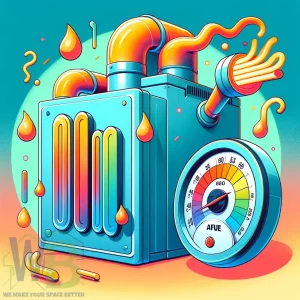Heating our homes is essential, especially during cold seasons. One effective way to do this is through hydronic heating systems. But what exactly are these systems?
Hydronic heating uses water to transfer heat throughout a building. It’s different from traditional forced-air systems and offers unique advantages.

Quick Summary
| Section | Key Points |
|---|---|
| Introduction | Hydronic heating systems use water to heat spaces; known for efficiency and comfort. |
| What is Hydronic Heating | Circulates heated water through pipes to radiators, underfloor systems, or convectors for warmth. |
| How It Works | Water is heated in a boiler, circulated through pipes, and radiates heat from emitters. |
| Pros and Cons | Pros: Even heat distribution, energy efficiency, comfort. Cons: Higher initial costs, maintenance. |
| Different Types | Includes radiant floor heating, radiator panels, hydronic towel rails, and convectors. |
| Conclusion | Hydronic heating is versatile, efficient, and suits various needs and spaces. |
What is a Hydronic Heating System?
Hydronic heating systems are a smart way to warm up a building. They use water, a great conductor of heat, to distribute warmth evenly.
This system heats water in a boiler, then sends it through pipes to radiators, underfloor systems, or convectors in different rooms. The heat from the water then spreads into the living space, comfortably warming it.
Advantages of Hydronic Heating
- Efficient Heat Distribution: Hydronic systems spread heat more evenly than traditional heating methods. This means fewer cold spots in your space.
- Energy Savings: They can be more energy-efficient, saving money in the long run.
- Healthier Air Quality: Hydronic heating doesn’t circulate dust or allergens, unlike forced air systems. This makes it a healthier choice, especially for people with allergies.
- Comfort: Radiant floor heating, a type of hydronic system, warms the floors. This is especially nice on cold mornings, making floors cozy to walk on.
Hydronic heating systems offer a comfortable, efficient, and healthy way to heat buildings. Their ability to use different energy sources and provide consistent warmth makes them a popular choice for many.
How Does Hydronic Heat Work?
Hydronic heating is a clever way to keep spaces warm and cozy. It moves hot water around in a closed loop of pipes, reaching different building parts.
This system is different from the ones that blow hot air around. Instead, it uses the heat from the water to warm up rooms in a more balanced and gentle way.
The Process of Heating
- Heating the Water: It starts with the boiler, which heats the water. This can be powered by gas, electricity, or heat pumps.
- Circulating the Water: The hot water then travels through a network of sealed pipes.
- Radiating the Heat: When the hot water reaches radiators, underfloor systems, or convectors, it releases heat.
Why It’s Great
- Even Heat Distribution: The heat spreads evenly, making the room feel warm. No more cold spots or sudden temperature changes.
- Energy Efficient: This system is good at saving energy. That means it can be kinder to your wallet and the environment.
- Consistent Warmth: Hydronic heating gives a steady, non-drying warmth. It’s like a gentle, ongoing hug for your room!
- Healthier Air Quality: Since it doesn’t blow air around, it doesn’t spread dust or allergens. This makes it a healthier choice, especially for those with allergies.
Hydronic heating is a smart, efficient, and comfortable way to heat spaces. It’s perfect for people who want even warmth without the air quality issues of forced air systems.
Pros and Cons of Hydronic Heating Systems
Here’s a table comparing the advantages and disadvantages of hydronic heating systems:
| Pros | Cons |
|---|---|
| Even Heat Distribution: Spreads warmth uniformly throughout the space. | Initial Cost: Installation can be more expensive than other heating systems. |
| Energy Efficiency: Often more energy-efficient, reducing long-term costs. | Maintenance: May require regular maintenance to ensure efficient operation. |
| Comfortable Warmth: Provides a comfortable and consistent heat. | Slow Response Time: Takes longer to adjust temperatures compared to forced air systems. |
| Quiet Operation: Operates more quietly than forced air systems. | Retrofitting Challenges: Can be difficult to install in existing buildings without existing pipework. |
| Improved Air Quality: Reduces circulation of dust and allergens. | Limited Cooling Options: Typically does not include a cooling function. |
| Flexibility in Energy Sources: Can be powered by gas, electricity, or heat pumps. | Leakage Risk: Potential for leaks in the piping system. |

Different Types of Hydronic Heating Systems
Hydronic heating systems come in various forms, each fitting different needs and spaces. Let’s look at some common types:
1. Radiant Floor Heating
- Description: This involves tubes filled with hot water or electric heating elements under the floor.
- Advantages: It heats evenly and consistently, making it ideal for new constructions or renovations.
- Applications: Best for homes or buildings with comfortable, desired floor-level heat.
2. Radiator Panels
- Description: These traditional heaters use hot water to warm the air around them.
- Varieties: Available in designs like cast iron and steel panels.
- Applications: Suitable for both homes and business spaces, offering a classic heating solution.
3. Hydronic Towel Rails
- Description: Designed to warm towels and the bathroom.
- Features: They come in various styles and sizes, adding warmth and a touch of luxury.
- Applications: Perfect for bathrooms, enhancing comfort and convenience.
4. Convectors
- Description: These heat the space with hot water and a fan or natural air movement.
- Placement: Can be installed in walls or as standalone units.
- Applications: Great for areas where quick heat response is needed.
Each type of hydronic heating system offers unique benefits. For instance, radiant floor heating is known for its comfort and even heat, while radiator panels are a classic, effective choice.
Convectors respond quickly to temperature changes, and hydronic towel rails add warmth to bathrooms. The right choice depends on your specific needs and the layout of your space.
Wrapping Up: The Essentials of Hydronic Heating Systems
In conclusion, hydronic heating systems present a versatile and efficient solution for warming up spaces. Whether through radiant floor heating for an even, cozy warmth underfoot, traditional radiator panels for a consistent heat source, stylish hydronic towel rails for bathroom luxury, or convectors for quick and effective heating, these systems cater to diverse needs and preferences.
While considering factors like cost, maintenance, and suitability for your space, hydronic heating stands out as a reliable, comfortable, and energy-efficient choice for both residential and commercial environments.







